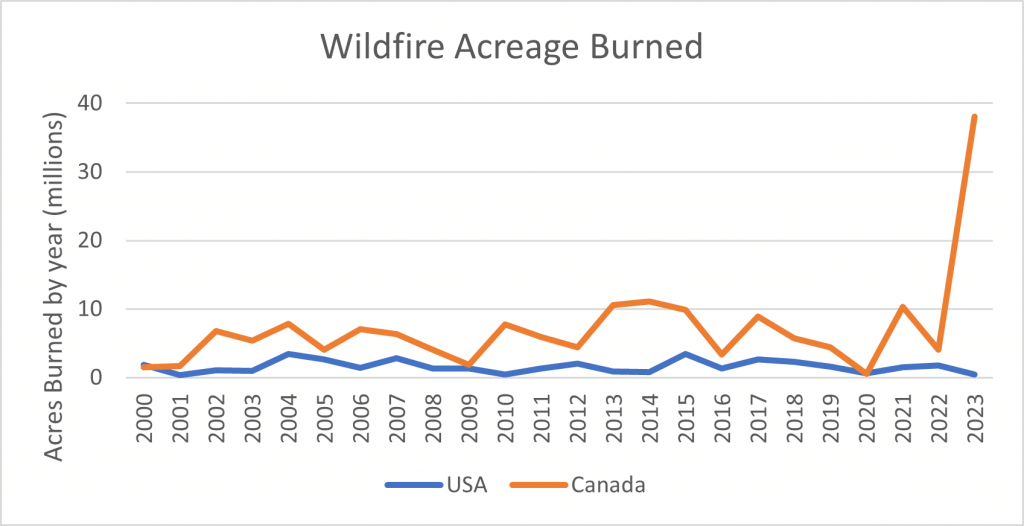
Wildfire Season 2023 – A Look at the Human and Environmental Toll
Wildfire. As long as dense forests and mid-latitude summers have existed, the hot, dry days of summer and wildfire have been locked in a dance of fortunes. Some say forests need wildfire for purification and rejuvenation. Others see the environmental impairment this dance can cause and seek to intervene. Can pre-emptive forest management limit the losses while maintaining forest health? What of wildfires borne of human carelessness or indifference? These are big questions with no easy answers. The 2023 wildfire season in North America has been notable for the scale of both environmental devastation in Canada and human tragedy in Hawaii. Here we offer up some thoughts in an attempt to better understand these challenges.
History of Wildfire in Hawaii
Certainly, the tragedy of the Maui wildfires this summer is unprecedented. It is, however, not the first Hawaiian wildfire nor will it be the last. The first reported wildfire event in Hawaii occurred on the islands’ Hāmākua Coast in 1901. That event burned nearly 30,000 acres within 3 months and resulted in the development of Hawaii’s Forest Reserve System.[1] The islands were faced with wildfires in the early 2000s as well, with an average of almost 21,000 acres burned annually from 2005 to 2011.[2] The scale of these fires in proportion to the island’s size, however, causes disproportionate impact to the ecosystems and local communities. Despite Hawaii being one of the smallest states (ranked 47th in size), the percent of total land burned annually is 0.48% compared to the 0.30% of the continental U.S.[3] According to the Hawaii Wildfire Management Organization in 2018, this past century has seen a 400% increase in area burned by wildfire. The wildfires of 2023 seem to confirm this trend.
Wildfire Statistics: USA and Canada
A good first question to ask in the aftermath of tragedy is, how, if any, is the current tragedy different from previous experience? According to the U.S. Forest Service, there are 750 million acres of forest in the U.S., covering 34% of the land area. By comparison, Natural Resources Canada records 900 million acres of forest covering 40% of the land area. Combined, this represents nearly 17% of the world’s forests. Between 2000 and 2022, the U.S. saw an average of 1.7 million acres (0.2%) taken by wildfires each year. During 2023, the US has not been notably different in that regard. In Canada, the average was 5.8 million acres (0.6%) each year. As the chart below shows, 2023 has been an unprecedented year for wildfires in Canada. As of mid-September, 43 million acres had already burned, over 6× the average and over double the previous high ever recorded. Nearly 1000 fires were still burning with over half deemed “out of control”. While it is fortunate that the human toll in Canada has not been as tragic as it has in the U.S., the toll on the environment is unprecedented, with impacts felt on both sides of the border.

Historically, the visual destruction of vast acreages of trees, while distressing to see, was understood to be an insignificant environmental concern. Fires eliminated excess accumulations of dead trees and other vegetation, and the forest would start regenerating the next year. A decade after the fire, tree density would have returned to at least 50% of its pre-fire levels. In summary, periodic wildfires were viewed as positive for long-term forest health. Unfortunately, this understanding has not held up into the 21st century. A group of forestry experts from across the U.S. published a study[4] in 2018 suggesting that significantly less tree regeneration has been occurring post-fire during the start of 21st century compared to previous time periods. The change has been driven by warmer and drier conditions throughout the U.S., resulting in longer recoveries to pre-fire densities, or a permanent shift to a less dense or even non-forest cover. Low-elevation forests, dominated by tree species near the warm, dry edge of their climatic tolerance are expected to be most vulnerable to shifts to a non-forest ecosystem. Moist forest types are expected to see a shift in species make-up and a decrease in tree density. Previously, short post-fire periods of wetter weather have favored tree regeneration. Going forward, these may not occur frequently enough to facilitate tree regeneration.
Soil Structure Changes and Runoff Risk
After a fire, runoff has the potential to be a large source of contaminants to downstream areas. Intact forests retard flows of water after a storm and act as sinks for the many pollutants that become trapped in the soil. The loss of vegetation and changes in soil properties from a fire greatly increase the magnitude of storm runoff and cause soil to move with the water more easily, resulting in sediment-laden floods carrying high concentrations of particulate-bound contaminants. Researchers at UCLA[5] looking at movement of heavy metal contaminants post fire, found concentrations were up to three orders of magnitude greater than pre-fire values for many metals, including lead (Pb) and cadmium (Cd). A shift was also observed in the timing of chemical delivery, where maximum suspended sediment and trace metal concentrations coincided with, rather than preceded, peak discharge volumes in the post-fire runoff. The results emphasize the importance of sediment movement as a primary mechanism for post-fire contaminant transport and suggest that traditional management practices that focus on treating only the early portion of storm runoff may be less effective following wildfire. A better understanding of the potential for watersheds impacted by regional urban pollutants to pose significant risk for downstream communities and ecosystems after fire could aid in mitigating these risks. The study’s authors suggest the use of flood control structures that retain sediment along with monitoring of pollutant loading of captured sediment prior to disposal may be the best way to manage this risk.
Dioxin and Furan Impacts
Dioxins and furans (collectively PCDD/F) include 210 related chemicals. They have no viable commercial uses but are often produced as side-products in the production of other industrial chemicals. Probably the best known is TCDD([6]), which was a side-product in the production of the defoliant Agent Orange, which first came to wide recognition during the Vietnam War. In total, 17 of the 210 chemicals in this class are recognized as potent toxins to humans and wildlife. Both Canada and the United States have been working to reduce the anthropogenic (i.e., human-caused) release of these compounds for several decades. However, PCDD/F are also produced in significant quantities during wildfires. Interestingly, because PCDD/F contain chlorine, forests close to the ocean produce more PCDD/F than inland forests during a wildfire, due to sodium chloride deposited onto the landscape from sea spray.
Because the 17 toxic PCDD/F vary greatly in their levels of toxicity, with TCDD being the most toxic, PCDD/F releases are measured in TCDD equivalent masses; referred to as Toxic Equivalents (TEQ). That is, for a compound that is 10× less toxic than TCDD, a release of 10 g of that compound is considered a toxic equivalent to 1 g of TCDD (i.e., 1 g TEQ). In 2000, human-caused releases of PCDD/F in the U.S. were equivalent to 1400 g TEQ (e.g., garbage incineration, vehicle fuel burning, cement and steel making). In Canada, it was 200 g. Wildfires in the U.S. that same year caused the release of 4600 g TEQ. Canada saw less wildfire acreage burned that year for a total of 3700 g TEQ. In the case of wildfire, some of these contaminants are already present in the landscape, having been sequestered in the soil and vegetation over many years, and are simply re-distributed during a wildfire. However, the majority of PCDD/F (~90%), are produced during the burning process. Post-fire, of all the PCDD/F released during a fire about 10% remains in the ash and debris at the wildfire site with the rest moving with the smoke plumes, to eventually be deposited hundreds or thousands of miles downwind.
The urban wildfire situation is a bit different. Generation of PCDD/F in an urban wildfire is dependent on what materials are being burned and can be very different from one location to the next. When burned, polyvinylchloride (PVC) plastics, which are widely used in housing (e.g., vinyl siding, window casings, drainage pipes), produce significantly more PCDD/F than wood. As a result, from one structure site to another in an urban environment, TEQs measured in the soil and ash can vary from 100×-1000× higher than those seen in wildland wildfire sites.[6],[7]
Heavy Metal Impacts
Toxic heavy metals such as Pb, Cd, chromium (Cr), copper (Cu), arsenic (As), and zinc (Zn) are not produced during a wildfire but are rather redistributed, in sometimes unexpected ways. The Arroyo Secon watershed, adjacent to Los Angeles, had not burned in 60 years prior to the 2009 Station Fire that burned the entire watershed. As a result, it had been a sink for pollutants generated in the Los Angeles region for a long time. The UCLA researchers5 noted that the Station Fire resulted in higher amounts and flows of runoff from the watershed, along with higher amounts of suspended sediment and chemical concentrations arriving later, relative to those previously seen. While only the largest pre-fire storm was able to mobilize contaminants from the watershed, even small post-fire storms produced concentrations that exceeded water quality criteria, at levels more typical of drainage from highways, industrial areas and mining operations. Post-fire, the mass of sediment per water volume increased 10×. At the same time the concentrations of heavy metals in the sediments increased as well. While As concentrations increased less than two-fold, Cu increased 4×, Zn 10×, and Pb & Cd 100×.
As was the case with PCDD/F, wildfire effects on heavy metal redistribution were not only a concern for local watersheds but also contributed dramatically to decreased air quality. Increases in fine particulate matter containing heavy metals increases the risk of poor health outcomes, affecting locals who return and responders who serve. While local concentrations are highest, the impacts can be noticeable at great distances downwind as well. During the 2-week long 2018 California Camp fire, elevated levels of Pb and Zn were detected and smoke containing these metals traveled more than 150 miles.[8] At the same time, the California Air Resources Board saw a > 300× increase of particulate matter over the average for the same period between 2010 and 2017. Short-term exposure to fine particulate matter alone is strongly linked to increases in respiratory diseases such as asthma and chronic obstructive pulmonary disease along with hospital admissions. Wildfire heavy metal contaminants affect more than the lungs, however. Metals such as potassium (K), aluminum (Al), nickel (Ni), and Zn exposure have led to an increased risk of cardiovascular disease, while the bioaccumulation of As, Pb, and Al increased the risk for mortality. The World Health Organization’s International Agency for Research on Cancer (IARC) lists As, Cd, and Cr as human carcinogens.[9]
PCDD/F and heavy metals released during wildfires have important implications for everyone exposed to wildfire smoke and debris. While critical at a wildfire site, appropriate personal protective equipment (PPE) should be considered for anyone surrounded by plumes of wildfire smoke. As we saw this year, such conditions can occur very far away from the fire site. Limiting your exposure is always best.
Helping Those Affected
While those of us not directly in harm’s way cannot help to put out the flames, we can still provide support to those displaced by the fires. Whether people have lost homes and loved ones or are displaced and living for days or weeks in temporary lodgings far from home, the personal financial costs of wildfires can be overwhelming. The Canadian and American Red Cross Wildfire Resources webpages have many safety and recovery tips for before, during and after an urban wildfire event. It is also a great place to donate if you want to provide general financial assistance to those most in need of recovery assistance after a wildfire.
USA: https://www.redcross.org/get-help/how-to-prepare-for-emergencies/types-of-emergencies/wildfire.html
If you are more interested in helping out in Maui specifically, here are organizations to consider.
- Maui United Way is providing financial assistance to those within the fire impact zone https://mauiunitedway.org/
- Donate or hold a Virtual Food Drive with the Maui Food Bank to support displaced people https://mauifoodbank.org/
Parting Thoughts
Humans, for millennia, have attempted to tame the wilderness. Indeed, the harnessing of fire has in part defined our species. Our industrious nature has elevated us to the level, in the current Anthropocene era, of being the dominant species on the globe, capable of altering the globe’s very course through the epochs. As someone once said, with great power comes great responsibility. It is vitally important that we continue the hard work of managing our relationship with wildfire, seeking to find that balance between the needs of the landscapes we live in and the people we live with. When we get it wrong, we need to learn, assist in recovery, and plan to do better next time. When we succeed, it is cause for celebration.
[1] Ka’anapu, K. “Paradise On Fire: How Hawai ‘i Developed one of the Worst Wildfire Problems in America.” Intersections: Journal of Asia Pacific Undergraduate Research, Vol. 1.1 (2023): 53-69.
[1] Trauernicht, C., and Hawaii Wildfire Management Organization. “Wildfire occurrence in Hawaii 1904–2021.” Pacific Fire Exchange, (2021). https:// pacificfireexchange.org/regions
[1] Trauernicht, C., E. Pickett, C. Giardina, C.M. Litton, S. Cordell, and A. Beavers. “The contemporary scale and context of wildfire in Hawaii.” Pacific Science. Vol. 69, No. 4 (2015): 427–44.
[1] Stevens-Rumann, C.S., K.B. Kemp, P.E. Higuera, B.J. Harvey, M.T. Rother, D.C. Donato, P. Morgan, and T.T. Veblen. “Evidence for declining forest resilience to wildfires under climate change.” Ecology Letters, Vol. 21 (2018): 243–252.
[1] Burke, M.P., T.S Hogue, A.M. Kinoshita, J. Barco, C. Wessel, E.D. Stein. “Pre- and post-fire pollutant loads in an urban fringe watershed in Southern California.” Environ. Monit. Assess., Vol. 185 (2013):10131–10145.
[1] Gullett, B. A. Touati, L. Oudejans. “PCDD/F and aromatic emissions from simulated forest and grassland fires. Atmospheric Environment. 2008, 42(34): 7997-8006.
[1] Deardorff, T.L., N.J. Karch, and S.E. Holm. Dioxin Levels in Ash and Soil Generated in Southern California Fires.” Organohalogen Compounds, Vol. 70, (2008): 002284-002288.
[1] McNeill, J., G. Snider, C.L. Weagle, et al. “Large global variations in measured airborne metal concentrations driven by anthropogenic sources.” Sci. Rep., Vol. 10, (2020): 21817. https://doi.org/10.1038/s41598-020-78789-y [38 authors]



